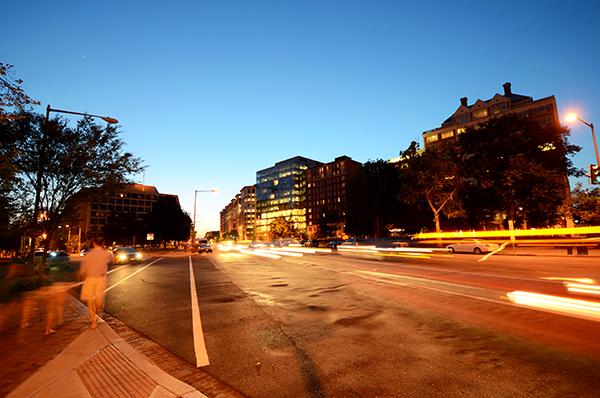You might notice that the area between Foggy Bottom and Dupont Circle feels pretty quiet at night.
That’s because while about 85,000 people filter through the area, known as the Golden Triangle during the work day, only 2,000 residents live there year round. But now local officials in the area’s Business Improvement District are pushing agendas to make the area more “vibrant,” changing some of the area’s spaces into apartment buildings, adding more residential buildings and attracting new types of businesses.
For students, the increased number of people living in the area could spur more restaurants and retail spaces just off campus that would draw more people to the area later in the evening, David Suls, the director of planning and economic development for the Golden Triangle BID, said.
He said the change would make going off campus feel like less of a transition for visitors, who might see a stark difference from the more populated areas of Foggy Bottom and the less residential parts of the Golden Triangle.
“I think it will make the area around GW’s border more porous,” Suls said. “They’ll feel less like they’re going from campus to offices.”
The Golden Triangle BID is a nonprofit corporation that seeks to keep the area clean and safe, while also maintaining and attracting new businesses. Suls said members of the group would like to see more residential buildings in the area and after crunching the numbers more thoroughly, will look into seeing if giving businesses financial incentives to go residential will bring more permanent residents to the area.
“Even just a couple buildings changing could make a big difference,” Suls said.
Suls said his organization tries to make the area more attractive and show people the “potential of the neighborhood.” The group makes use of the area’s six national parks by holding events like displays of public art, hosting lawn games and presenting musical performances.
“We’re doing all this to make the neighborhood more interesting, make it a place where you would want to stay and do more than just working,” Suls said.
Chris Leinberger, the chair of GW’s Center for Real Estate and Urban Analysis, said that the increased development in the Golden Triangle area could spill over into the development of I Street on campus, expanding the row of businesses in an “upward spiral.”
“All of that land is owned by the University and could be further developed,” Leinberger said. “More people means more demand to build that second entrance into the metro station.”
Ward 2 Council member Jack Evans, who represents Foggy Bottom, has prioritized adding an additional entrance to the Foggy Bottom metro station on his agenda for this year.
Marina Streznewski, president of the Foggy Bottom Association, said she would welcome the added houses if the increase in population helped decrease the demand and prices for housing closer to Foggy Bottom to “sane” levels.
“If increasing the amount of housing becomes more affordable here, then it’s good,” Streznewski said. “But if it’s luxury and for singles as opposed to family units, then it should be thought about carefully.”
John Sikaitis, the managing director of office research and local markets research for the real estate investment management firm JLL Development, said that the area is not anywhere near becoming more residential, but that it is “probably craving” the development.
“A lot of people would like to see greater diversity,” Sikaitis said.
Sikaitis said there would need to be economic incentives to convince commercial property owners to switch their properties from commercial to residential zones, since it could be a million-dollar investment to fit a building for apartments. Possible incentives could include construction subsidies from the city or tax breaks.
But in spite of the obstacles, there are more residential properties popping up in other areas near campus that were originally office spaces. The former headquarters of the Association of American Medical Colleges in the West End will soon be transformed into luxury condominiums. An abandoned Dupont Circle office building on 22nd Street will also be converted to residential units.
Jeannette Chapman, a research associate for George Mason University’s Center for Regional Analysis, said that some of the older office buildings may be become “obsolete” as redevelopment continues.
“It may make as much financial sense to try to convert it to residential buildings,” Chapman said.







